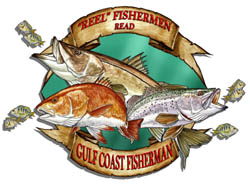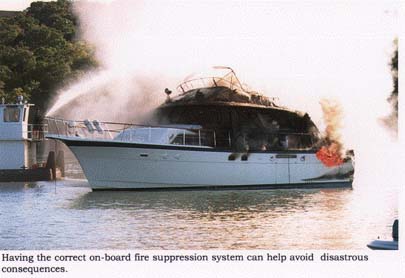
The Saltwater Magazine for Gulf Coast Fishing!
FISHING FORECASTS | FISHING CALENDARS | ARTICLES | ADVERTISE | SUBSCRIBE
Search Gulf Coast Fisherman's
Web Site
Past articles, specific
places or fish, etc.

CHOOSING THE CORRECT ON-BOARD
FIRE PROTECTION
by Ernie Ellis
![]()
| CURRENT
MOON lunar phases |
GULF COAST
FISHERMAN T-Shirts
GCF
T's are here!
We all know that preventing fires aboard the boat is much easier and more cost-efficient than repairing the damage caused by them. With that in mind, choosing the right fire protection for your craft is crucial to its survival and that of the crew and passengers.Portable fire extinguishers are a necessity.

They can be mounted nearly anywhere for quick access and are most effective on small fires, such as in the galley or the accommodation area. All marine craft should be equipped with portable fire extinguishers.
Protecting the engine compartment with automatic fire extinguishers is critical as well. Pre- engineered, or fixed, fire extinguishers come in a variety of sizes and feature automatic, heat-activated discharge. Automatic systems are sized to protect areas ranging from 35 cubic feet up to 1,000 cubic feet. With a manual discharge cable, the approved size range is up to 1,500 cubic feet.
Engineered fire extinguishing systems are typically used to protect boats and yachts with larger engine compartments (over 1,500 cubic feet). These systems are custom engineered and designed for each engine compartment application. Distribution nozzles and piping are part of the system. Discharge occurs automatically with heat activation or manually with a pull cable.
An important element of fire protection is the extinguishant. For many years, halon was the preferred choice for marine fire protection because it was residue-free, clean and very effective as an extinguishant. However, its use has been banned in many countries.
Currently, the United States permits the use of recycled halon. Recycled halon is halon that is extracted from decommissioned extinguishing systems, cleansed and recycled to industrystandards. It is an environmentally responsible and practical means of using existing halon.
HCFCs (hydrochlorofluorocarbons) are available as a replacement for halon. HCFCs are not as damaging to ozone as halon is, but they still cause harm. HCFCs are banned in Europe and have restrictions on applications in the U.S.
Using carbon dioxide as an extinguishant is another option. However, it is a high-pressure gas that can be difficult to store. A sudden release of carbon dioxide may cause thermal shock and damage equipment. It is also unsafe and not acceptable for use in occupied areas.
FM-200 is an extinguishant that is safe for use in occupied spaces and is accepted in over 70 countries throughout the world. It works by removing the heat energy from a fire and offers quick, effective, clean extinguishing performance. FM-200 causes no stratospheric ozone depletion and does not cause damage to sensitive equipment.
Sea-Fire Marine, of Baltimore, Maryland, offers automatic and manual/ automatic FM-200 fire suppression systems in configurations for both gas and diesel engine applications. The systems protect engine compartments ranging from 50 up to 17,500 cubic feet in volume.
From Sea-Fire Marine, 933 1 -A Philadelphia Rd., Baltimore, MD 21237. Phone: 800-445-7680. Website: http://www.sea-fire.com. Editor's Note: Ernie Ellis is president of Sea-Fire, a Baltimore, Maryland-based manufacturer of marine fire extinguishing systems for over 20 years.

